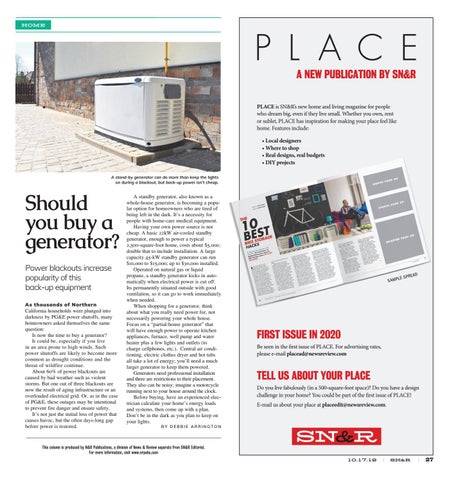home
A new publicAtion by Sn&R PLACE is SN&R’s new home and living magazine for people who dream big, even if they live small. Whether you own, rent or sublet, PLACE has inspiration for making your place feel like home. Features include: • Local designers • Where to shop • Real designs, real budgets • DIY projects A stand-by generator can do more than keep the lights on during a blackout, but back-up power isn’t cheap.
Should you buy a generator? Power blackouts increase popularity of this back-up equipment As thousands of Northern
California households were plunged into darkness by PG&E power shutoffs, many homeowners asked themselves the same question: Is now the time to buy a generator? It could be, especially if you live in an area prone to high winds. Such power shutoffs are likely to become more common as drought conditions and the threat of wildfire continue. About 60% of power blackouts are caused by bad weather such as violent storms. But one out of three blackouts are now the result of aging infrastructure or an overloaded electrical grid. Or, as in the case of PG&E, these outages may be intentional to prevent fire danger and ensure safety. It’s not just the initial loss of power that causes havoc, but the often days-long gap before power is restored.
A standby generator, also known as a whole-house generator, is becoming a popular option for homeowners who are tired of being left in the dark. It’s a necessity for people with home-care medical equipment. Having your own power source is not cheap. A basic 22kW air-cooled standby generator, enough to power a typical 2,500-square-foot home, costs about $5,000; double that to include installation. A large capacity 45-kW standby generator can run $10,000 to $15,000; up to $30,000 installed. Operated on natural gas or liquid propane, a standby generator kicks in automatically when electrical power is cut off. Its permanently situated outside with good ventilation, so it can go to work immediately when needed. When shopping for a generator, think about what you really need power for, not necessarily powering your whole house. Focus on a “partial-house generator” that will have enough power to operate kitchen appliances, furnace, well pump and water heater plus a few lights and outlets (to charge cellphones, etc.). Central air conditioning, electric clothes dryer and hot tubs all take a lot of energy; you’ll need a much larger generator to keep them powered. Generators need professional installation and there are restrictions to their placement. They also can be noisy; imagine a motorcycle running next to your house around the clock. Before buying, have an experienced electrician calculate your home’s energy loads and systems, then come up with a plan. Don’t be in the dark as you plan to keep on your lights.
samp
le sp
read
FiRSt iSSue in 2020 Be seen in the first issue of PLACE. For advertising rates, please e-mail placead@newsreview.com
tell uS About youR plAce Do you live fabulously (in a 500-square-foot space)? Do you have a design challenge in your home? You could be part of the first issue of PLACE! E-mail us about your place at placeedit@newsreview.com.
By DeBBie Arrington
This column is produced by N&R Publications, a division of News & Review separate from SN&R Editorial. For more information, visit www.nrpubs.com
10.17.19
|
SN&R
|
27
